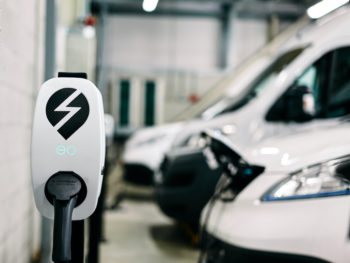David Savage, regional manager – UK & Ireland at Geotab, looks at how telematics solutions can transform insights into fleet charging operations, providing a platform for future innovation.

In a world where both public pressure for decarbonisation and government incentives towards it are growing rapidly, electrification is increasingly seen as a business imperative by companies operating fleets. Indeed, in a recent survey of fleet managers in the UK performed by Geotab, we found that 89% of companies expect EVs to play a dominant role in their fleets by 2028, and just 2% have no current plans to make the switch to electric. Meanwhile, the number of options on the market for battery-powered commercial vehicles is multiplying, costs of purchase and ownership are becoming increasingly competitive with traditional alternatives, and in the UK the Government is planning to bring forward the end-date for internal combustion engine (ICE) vehicle sales.
In spite of all of this desire to act and positive momentum making that action possible, fleet managers still face a series of knotty questions when contemplating how to make electrification a reality in their own businesses. Indeed, the sheer variety of EV options now available to businesses – even while it makes it more likely that the right option will exist –makes deciding on a path all the more complicated. The capital cost of fleet transformation means that having future-proof technology can be make-or-break for firms, and real-world performance information is not always transparent.
This situation is exacerbated when, as often happens, a fleet requires vehicles of different sizes, operating on different duty cycles, and likely from different manufacturers. The logistics of charging an electric fleet, where vehicles may need to dwell in bays with appropriate infrastructure for hours, rather than the minutes it takes to fill a fuel tank, can be complex , even when the fleet is composed of a single vehicle type. When you add in a variety of vehicles with differing needs, guaranteeing that balance between charging capability and energy usage requirements can start to seem impossible.
Data to the rescue

This mix of challenges – simultaneously building a diverse fleet and managing infrastructural charging capacity while keeping the system as a whole administratively manageable – is precisely where Gnewt found itself some years ago.
Established in 2008, Gnewt (Green New Transport), by Menzies Distribution, is a pioneer in electrification and has a fully electric commercial vehicle fleet. Delivering zero-emission final-mile logistics for retailers and third-party logistics companies, Gnewt’s fleet of double payload modified vans has delivered around 10 million parcels, with each driver travelling approximately 25 miles a day, making 50-60 drops, equating to anywhere between 100 to 150 parcels.
During its growth, Gnewt found itself facing a situation where it could only charge around 35 vehicles per day and needed to build on a nascent, complex infrastructure while expanding its fleet and managing costs to compete with firmly established companies operating on internal combustion engines.
In order to optimise existing systems and so create headroom for further growth and innovation, Gnewt turned to the power of data. The fact that vehicles, like most other technologies, are getting more intelligent is no secret: many of the vehicles in Gnewt’s mixed fleet have pre-installed reporting systems for aspects like charge status and charging time. However, the lack of interoperability between different manufacturers’ systems made it difficult to action this data.
By implementing a modern third-party telematics platform, Gnewt was able to gather this information – and much more – into a single system, turning data into insight which can make the fleet charging operation more efficient. With oversight of charging progress on a per-vehicle basis, and the opportunity to analyse how changes to the process affect throughput and dwell time, Gnewt was able to increase its daily charging capacity to 80 vehicles, giving it vital room for growth.
More than just infrastructure
Digitising the charging process in this way also means that Gnewt now has the potential for more sophisticated ways of working with the grid. By installing smart chargers, it is already finding ways to power its buildings using energy left over in its vehicles at the end of the working day. Those vehicles can then be recharged overnight when electricity is cheaper, saving the firm money. In future, it might also be able to sell energy back to the grid at peak times, actually turning a profit on stored energy.
Vehicle-agnostic data platforms are a perfect match for vehicles which have the built-in ability to share data in a digital way. While Gnewt turned to telematics to help make scaling up its fleet economically viable, this data can also be a huge boon to companies just starting their electrification journeys. With advanced monitoring of existing ICE fleets, fleet managers can get real insight on what their vehicles do on a daily basis and choose the right electric solution for them, rather than relying on broad assumptions about performance and activity requirements.
As electric vehicle fleets mature, telematics can also provide intelligence about battery degradation, ensuring that vehicles continue to perform at the necessary level and further informing managers about which vehicles are best suited to their needs.
Ultimately, of course, the goal here is not to just collect data, or even to save money for the company – though that is of course a welcome effect. The prize on offer is transport and delivery infrastructure which can make business work without damaging the planet. For that, we should be turning to every tool we have available – and the power of data will be a key part of that.

